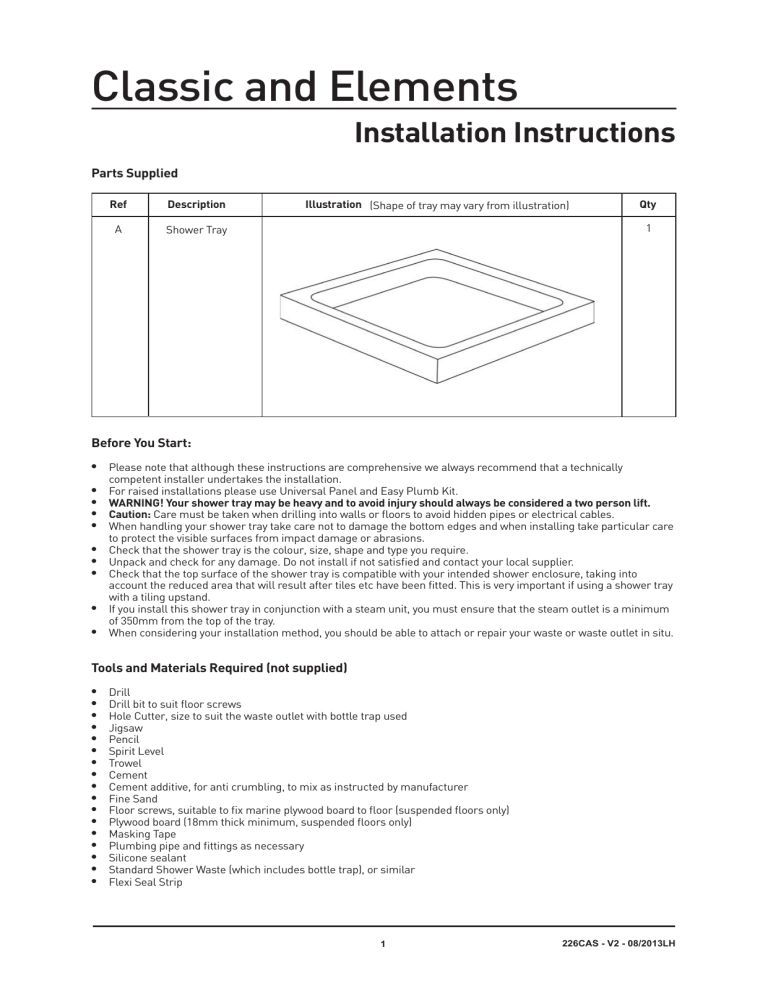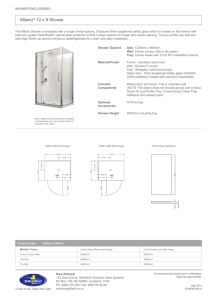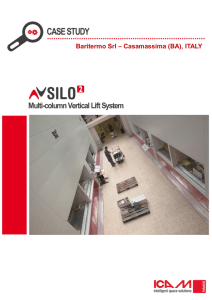Classic and Elements

Classic and Elements
Installation Instructions
Parts Supplied
Ref
A
Description
Shower Tray
Illustration (Shape of tray may vary from illustration) Qty
1
Before You Start:
•
Please note that although these instructions are comprehensive we always recommend that a technically competent installer undertakes the installation.
•
For raised installations please use Universal Panel and Easy Plumb Kit.
WARNING! Your shower tray may be heavy and to avoid injury should always be considered a two person lift.
•
Caution: Care must be taken when drilling into walls or floors to avoid hidden pipes or electrical cables.
When handling your shower tray take care not to damage the bottom edges and when installing take particular care to protect the visible surfaces from impact damage or abrasions.
•
Check that the shower tray is the colour, size, shape and type you require.
•
Unpack and check for any damage. Do not install if not satisfied and contact your local supplier.
Check that the top surface of the shower tray is compatible with your intended shower enclosure, taking into account the reduced area that will result after tiles etc have been fitted. This is very important if using a shower tray with a tiling upstand.
•
If you install this shower tray in conjunction with a steam unit, you must ensure that the steam outlet is a minimum of 350mm from the top of the tray.
•
When considering your installation method, you should be able to attach or repair your waste or waste outlet in situ.
Tools and Materials Required (not supplied)
•
Drill
Drill bit to suit floor screws
•
Hole Cutter, size to suit the waste outlet with bottle trap used
Jigsaw
•
Pencil
Spirit Level
•
Trowel
Cement
•
Cement additive, for anti crumbling, to mix as instructed by manufacturer
Fine Sand
•
Floor screws, suitable to fix marine plywood board to floor (suspended floors only)
Plywood board (18mm thick minimum, suspended floors only)
•
Masking Tape
Plumbing pipe and fittings as necessary
•
Silicone sealant
Standard Shower Waste (which includes bottle trap), or similar
•
Flexi Seal Strip
1
226CAS - V2 - 08/2013LH
Installation on Concrete Floors
1.
2.
3.
With the shower tray (A) in position mark the perimeter and waste hole on the floor including an area out side the perimeter for access to connect plumbing after the tray has been installed (See Fig 1). If using a shower tray with a built in tiling upstand or use of flexi seal strip allowance must be made for recessing the tray into adjacent walls to allow tiling down onto the tray surface (See Fig 1a).
Form a trench in the floor to hold the waste pipe and shower waste and extend to include the access area
(See Fig 1).
Install in accordance with plumbing regulations the waste pipe and shower waste (protecting any exposed threads with masking tape) in the trench, then blank off the trench so it remains clear (to enable plumbing connection) after laying a cement bed on the area to fully support the tray.
1 1a 2
Access Area
Note! Some shower trays have a protective film (indicated by a label on the surface) which must now be removed, undertake a final inspection of the tray at this stage. DO NOT PROCEED IF NOT SATISFIED.
4. If fitting the optional Flexi Seal Strip (Flat Top Trays only) follow the instructions on page 3 and attach the strip now.
Note! Before proceeding, dry fit all items in situ to ensure compatibility.
6.
7.
5. Mix fine sand, cement in accordance with the manufacturers instructions to a workable mix to cover the total area under the tray. Trowel to a thickness suitable to allow levelling and full support of the shower tray
(See Fig 2).
Note! Silicone sealants, foams, mastics, installation compound adhesive* or similar MUST NOT be used as a substitute for cement.
* Except when used with the Universal Panel and Easy Plumb Kit.
Place the shower tray (A) onto the wet cement and ensure it is fully supported by the mix. Level the top rims only as the shower tray has a built in fall for adequate drainage (See Fig 3).
When the cement has set, remove any excess mix and masking tape then make connection between the shower tray and the waste pipe. The shower tray and all connections MUST now be checked for water tightness flow and adequate drainage over the entire area. DO NOT PROCEED IF NOT SATISFIED.
8. After all checks and adjustments, seal along the tiling line with silicone sealant (See Fig 4).
Note! When fitting a shower enclosure refer to the manufacturers installation instructions
9. Fill in the access area and the waste pipe trench beneath the shower tray (A) with cement to give full support to the shower tray in service.
3 4
Installation on Suspended Floors
1. Place shower tray (A) in position, mark the perimeter on the floor including an area outside the perimeter for access to connect plumbing after the tray has been installed (See Fig 5). If using a shower tray with a built in tiling upstand or use of Flexi Seal Strip allowance must be made for recessing the tray into adjacent walls to allow tiling onto the tray surface (See Fig 1a page 2).
2
226CAS - V2 - 08/2013LH
2.
3.
The floor area (or larger) covered by the shower tray (A) must be removed and replaced with a single piece of plywood (min 18mm thick) and also access for the waste should be constructed.
Put the plywood in position, place the shower tray (A) on the plywood and mark the waste hole location (See
Fig 5).
4. Remove the shower tray (A), then use the hole cutter to drill a hole in the plywood large enough for the entire shower waste being used, which may need to be extended with the jigsaw to form a keyhole shaped cut-out for some types of shower waste. Keep all holes to the minimum (See Fig 6).
5. Remove the plywood and install the waste outlet pipe in accordance with building regulation.
Note! Some shower trays have a protective film (indicated by a label on the surface) which must now be removed, undertake a final inspection of the tray at this stage. DO NOT PROCEED IF NOT SATISFIED.
6.
7.
If fitting the optional Flexi Seal Strip, (Flat top shower trays only) follow the instructions on page 4 and attach the strip now.
Fit the shower waste to the shower tray (A) following the instructions supplied and protect exposed threads with masking tape. Before proceeding dry fit all items in situ to ensure compatibility and screw the plywood into position.
8. Mix fine sand, cement in accordance with the manufacturers instructions to a workable mix to cover the total area under the tray. Trowel to a thickness suitable to allow levelling and full support of the shower tray
(A) (See Fig 2 page 2).
Note! Silicone sealants, foams, mastics, installation compound adhesive* or similar MUST NOT be used to substitute for cement.
9.
10.
* Except when used with the Universal Panel and Easy Plumb Kit.
Place the shower tray (A) onto the wet cement and ensure it is fully supported by the mix. Level the top rims only as the shower tray has a built in fall for adequate drainage (See Fig 3 page 2).
When the cement has set, remove any excess mix and masking tape then make connection between the shower tray and the waste pipe. The shower tray (A) and all connections MUST now be checked for water tightness flow and adequate drainage over the entire area. DO NOT PROCEED IF NOT SATISFIED.
11. After all checks and adjustments, seal along the tiling line with silicone sealant (See Fig 4 page 2).
Note! When fitting a shower enclosure refer to the manufacturers installation instructions.
5 6
Flexi Seal Strip (Not Supplied with Tray) Installation Instructions
This product is intended as a flexible tiling upstand and should be fitted to the side of the tray adjacent the walls only.
1.
2.
Tools and Materials Required: (not supplied)
•
Damp Cloth
Scissors
•
Small Roller (or other appropriate tool)
Silicone sealent (or other suitable sealent)
Wipe the surfaces clean where the strip will be attached first with a clean damp cloth, allow to dry and then wipe with the IPA wipe supplied in the kit.
Determine the length of strip required to seal around the shower tray and cut to length with scissors. (Ensure you cut at least 20mm longer than needed).
3
226CAS - V2 - 08/2013LH
5.
6.
7.
8.
3.
4.
Peel back approximately 20cm of backing from the adhesive strip (See Fig 7).
Attach to the edge of the shower tray so that it is square and the edge protrudes at least 20mm above the edge of the tray, (See Fig 8) making sure the adhesive strip is positioned so that it will not come into contact with any silicone you are using at stage 8.
Using a small roller or other appropriate tool roll the seal strip so that it attaches firmly to the edge of the tray removing any bubbles or creases, paying particular attention to the corners (See Fig 9).
Gradually remove the cover strip in sections and roll on the seal so it attaches firmly and square to the edge of the tray, making sure there are no gaps between tray and seal strip. Trim off any excess strip.
Install the shower tray in the correct position and tile over the seal strip (See Fig 10).
Put a protective bead of silicone or other suitable flexible sealant between the tray and the tile, ensuring it does not come into contact with the adhesive material on the flexi seal strip.
7 Peel back 20cm of backing to start
8 Protrudes 20mm from edge of tray
9 10
Seal strip
Tile over seal strip
Care & Use of Your Shower Tray
These installation instructions should be retained and passed to the user for possible future reference.
Your shower tray can be maintained in an as near new condition for many years by following a simple cleaning procedure as follows:
It is normal for small amounts of localized water to be retained on the shower tray’s surfaces after use which should be wiped dry immediately to prevent build up of sediments.
The shower tray should be cleaned regularly with warm, soapy water only and dried with a cloth. Never use scourers, abrasives, bleach or other chemical cleaners.
Troubleshooting:
Q: The waste outlet in the shower tray is directly over an obstruction at floor level.
A: Consider switiching to a universal panel and Easy Plumb Kit or re-locating shower tray.
Q: The shower tray’s waste will not fit through the plywood and connection point.
A: Cut a slightly larger hole with a keyhole section over the connection point.
Q: There is water retaining on the surfaces of the tray.
A: Check that the shower tray is level (top rims) as it is normal for small amounts of localized water to be retained.
Q: The shower tray will not fit the space available.
A: Consider recessing the edge of the tray into adjoining walls or using a smaller shower tray and enclosure.
Q: Water will not flow fast enough down the waste outlet.
A: Check that the waste unit is correctly installed and that outlet pipe has sufficient angle and is not kinked causing
an air blockage.
Q: The enclosure will not fit on the shower tray.
A: Check that the available surface on top of the tray is compatible with the size, shape and adjustment range of
your enclosure, change enclosure if required.
Q: Water escapes from a fitted walkin or frameless enclosure.
A: It is normal for spillage to occur from walkin or frameless type enclosures, consider changing to a fully framed
enclosure.
Customer Care: 0845 505 2211
Monday - Friday 9am - 5pm
4
226CAS - V2 - 08/2013LH


